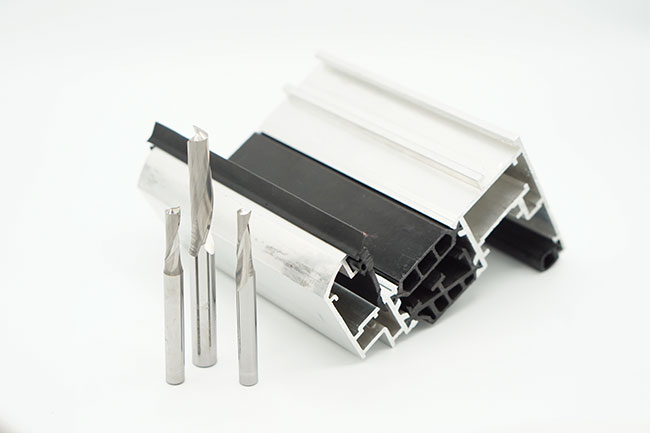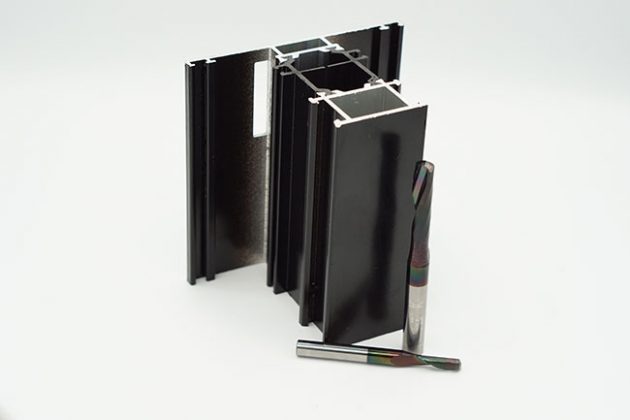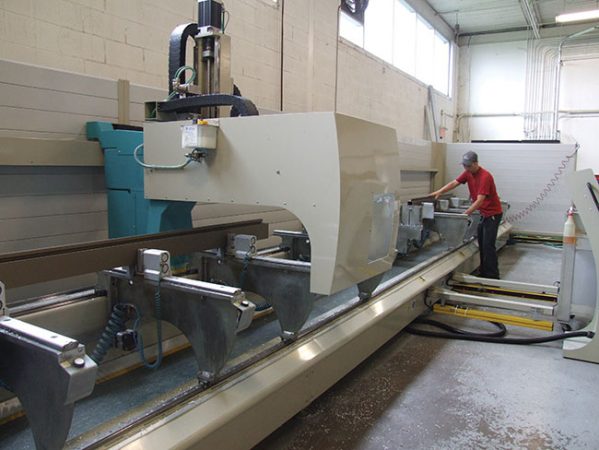
Features
Energy efficiency
Fabrication
Machinery
Efficient machining
The right endmill can make all the difference.
July 29, 2021 By Jonathan Chauvette
 If you need an endmill for a variety of tasks but purchase one that is specialized to do just one job, then you will need to buy more and end up losing money.
If you need an endmill for a variety of tasks but purchase one that is specialized to do just one job, then you will need to buy more and end up losing money. Aluminum extrusion is a manufacturing process used for aluminum forming, which involves the forced flow of a cylindrical billet through a desired cross section’s die. The extruded parts are then pushed out through a hydraulic or mechanical press. Aluminum extrusion involves machining. In recent years, one of the most popular cutting tools used in the process happens to be the endmill. Endmills are available in a wide variety of designs, and the most popular ones are ball endmills; corner rounding endmills; finishing endmills; roughing endmills; and square endmills.
In this article, you will find out all you need to know about buying the appropriate endmill for aluminum extrusion.
Choosing the right cutting tools
Cutting aluminum with the right tools can make the aluminum machining process much more efficient while maintaining accuracy. Aluminum is popular for two reasons; its ductility and malleability. However, problems begin to appear when the material is undercutting in aggressive conditions. Under such conditions,
aluminum becomes quite gummy and the fact that it sticks to flutes makes it bad news for cutting tools that are not fit for the job. The aluminum casting or melting process results in aluminum’s oxidation and causes all metal grades to develop abrasives. For the aluminum machining process to be smooth and accurate, the abrasives must be done away with.
The chip formation process often sees chips curling and this can result in them occupying more space than their pre-cut condition. As the chips stay firmly rooted in the flutes, they can be more difficult to cut for a second time. However, with an aptly designed endmill, there will be an extra evacuation area. If you want top-notch finishes, you have got to invest in cutting tools whose geometries are suited to work with aluminum. Without the correct tools that complement aluminum’s natural characteristics, you are bound to end up with poor finishes.
Buying the right endmill
In this article, we will talk about buying the best endmills for aluminum extrusion machining through 11 secrets that many people do not know about the process.
Secret 1: The key to aluminum machining is in knowing its consistency. The consistency of aluminum and its alloys can make the machining process a difficult one. Some of the commonly faced challenges during the aluminum milling process include chatter, aluminum’s abrasiveness, controlling the chips and quick machining. Aluminum is also one of the stickiest metals.
Ideally, an endmill created specifically for aluminum should have unevenly spaced flutes and should ideally have one or two flutes. Endmills with such flute design ensure that the harmonic vibrations created by flute impacts are kept to a minimum. The sticky and gummy nature of aluminum results in its chips sticking to endmills’ flutes. It is ideal to opt for endmills with the right radius. Even though extra finish passes may be required with such endmills during grinding, they ensure that sticky aluminum chips can be avoided even when using common lubrication. The abrasiveness across all grades of aluminum is also a common problem during the extrusion process. To avoid it, endmills that are coated with significant aluminum oxide concentrations are recommended.
Ultimately, when it comes to aluminum extrusion, the most perfect endmill is one that can slot, plunge, rough, profile and finish – and that n just one pass, too.
Secret 2: The aluminum grade you choose impacts the endmill you need to use. Even though the core characteristics of all aluminum grades are alike to some extent, there are several differences between them as well. Some of the factors that are commonly taken into consideration before deciding on a particular aluminum grade include corrosion resistance, formability or workability, heat treating, machining, strength, end-use applications and weldability.
There are two categories of aluminum alloys; cast alloys and wrought alloys. Aluminum’s cast alloys contain up to 22 percent alloying elements and wrought alloys contain up to four percent. While the difference may not seem to be a great one, the amount of alloying elements in a particular grade’s composition can significantly affect the material’s properties. Some of the common characteristics of cast alloys include tensile strength and low melting points. However, most aluminum products are wrought aluminum alloys, especially those manufactured from rolling and extrusion processes. Different grades of aluminum have different characteristics, which means that you need different endmills to work with them.
Secret 3: Carbide is not the only endmill material, but it is the best choice for machining aluminum extrusion. The endmills typically preferred for working with aluminum are made from solid carbide, which offers great rigidity and heat-resistance and is perfect for high-speed applications. However, carbide is not the only endmill material.
Cobalt endmills provide toughness, high hot hardness, and excellent wear resistance. However, cobalt endmills are not ideal for aluminum applications and are mostly used with steel, cast iron, and titanium alloys. Some endmills feature steel bodies with their tips made of carbide. They are known for their cutting prowess and are used on a wide variety of ferrous and non-ferrous materials such as steel alloys, steel and cast iron. Typically used across general-purpose milling applications of a wide variety of ferrous and non-ferrous materials, high-speed steel endmills cost less than both carbide and cobalt endmills. A synthetic diamond – polycrystalline diamond – has excellent wear and shock resistance properties. However, despite being a good option, its associated costs are significantly higher than those related to solid carbide. Powdered metal endmills are incredibly tough and less breakage prone. PM endmills are ideal for high-stock and high-shock applications like roughing. Vanadium high-speed steel endmills are made from carbon, high-speed steel, vanadium carbide and a wide variety of other alloys. They are ideal for working with high silicon aluminum and stainless steel.
While different endmill materials offer various properties, solid carbide endmills are the most highly rated in aluminum milling and extrusion as they can cut through aluminum smoothly and can last a long time as well.

A few benefits of using carbide endmills for aluminum extrusion are excellent surface finish quality; greater rates of stock removal at high feeds and speeds; and extended tool life.
Secret 4: You cannot use the same endmill for each extrusion machining scenario. Aluminum extrusion presents several different scenarios, such as contouring, finishing, high-efficiency milling, plunging, slotting and traditional roughing. In addition to these scenarios, there is the issue of metal thickness as well. What endmill you should use is dependent on these scenarios as different endmills are designed to perform various functions.
Square end (centre hole) endmills are heavily used for applications such as slotting, shoulder milling, and side milling. However, plunging is not possible using such endmills. Square end (centre cut) endmills too are ideal for slotting, shoulder milling, and side milling. However, plunging is possible using such endmills. The geometry of ball end endmills makes them ideal for curved surface milling. Corner radius end endmills are used for corner radius milling and radius profiling. Standard (straight shank) is the most widely used type of shank and neck part. Long shank is ideal for shoulder and deep pocket applications. Long neck is best suited to boring and deep slotting. Endmills with tapered neck features are perfect for mould draft and deep slotting applications.
Traditional flute geometry is typically used for applications such as roughing, shoulder milling, slotting and finishing side milling. Tapered flute geometry is ideal for applications such as applying taper angles post-completion of straight-edged milling. It is also used in mould drafts. Roughing flute geometry features a wave-like form and is used when the material needs to be broken into small chips. Regrinding is also possible thanks to the flute’s inside face. Formed flute is typically used to produce various components’ corner radii.
Secret 5: Your rookie endmill mistakes are costing you money. Losing money on endmills is mostly down to inevitable rookie mistakes. Not every endmill can handle all types of machining tasks. If you choose an endmill that can handle different tasks well, you will end up saving a lot of money in the long run. High-quality endmills will obviously require you to shell out more money than average tools. However, in the long run, you will have to spend less on maintenance. The kind of features that an endmill offers to users often dictates its price. Premium quality endmills boast of features such as a high-quality source of carbide, diamond polished flutes and preparatory edge geometry. Every endmill comes with the problem of chatter or vibration – it is something you just cannot avoid. However, with advancements in the technology that goes into the creation and design of endmills, there are many high-quality tools now that vibrate less.
Secret 6: Have you checked your energy footprint? It is this way because of your endmill. Minimizing endmills’ energy consumption will go a long way to reduce their carbon footprints and enhance their economic viability. Ninety percent of the environmental burden created by endmills is down to their electrical energy consumption. Most energy consumption studies conducted in the sphere of machining have been concerned with endmills and other cutting tools working at low speeds. However, in recent times, the focus has shifted to high-speed cutting because it is at the highest speeds that cutting tools consume the most energy and affect the environment. Along with cutting speed, the rate of metal removal also impacts how much energy an endmill will consume. The ideal way to reduce the environmental impact of endmills is to combine low to average cutting speeds with high metal removal rates.
Secret 7: Has your endmill got the right coat and geometry? You must consider the coats and geometries of endmills when selecting one for your machining purposes.
Coatings can significantly improve the performance of endmills. However, the chemical composition of a particular coat that works well with one endmill is not guaranteed to work with another endmill the same way.
Geometry is one of the key determinants of an endmill’s performance. High-helix and low-helix are two of the most chosen geometries, but both have their advantages and disadvantages. Endmills with high-helix geometries reduce tool deflection as the cutting forces are more vertical and less horizontal. Quicker chip evacuation, better shearing, durability and incredible strength are other advantages of the high-helix geometry. On the downside, high-helix endmills generate a lot of vibration or chatter and they are known for “biting” into the material, which can be problematic with soft materials. Low-helix endmills do not chatter or vibrate frequently and when it comes to machining soft materials, low-helix endmills are the preferred choice of machinists. However, low-helix endmills struggle to work with challenging and hard materials.
The most state-of-the-art endmills in today’s times are the variable-helix endmills that feature unevenly spaced flutes intending to reduce chatter. Many manufacturers use a “ski-flute” technique that involves providing as much rake as possible at the edge while keeping the characteristics of designs with a lower rake. Chamfer and corner-radius endmills are known for enhancing the surface finish and prolonging tool life.
Secret 8: Higher flute endmills do not always yield the best results. Flutes are an endmills’ deep spiral grooves facilitating chip evacuation and formation. How many flutes an endmill has determines on several things, such as the piece’s surface finish; the chip-clearing ability of the tool; and the machine’s feed rate. Feed rate is directly proportional to the number of flutes, so, the greater the number of flutes, the higher the feed rate must be. More flutes are recommended for smoother cuts. However, with more flutes comes the problem of chip evacuation, as there is very little space for the chips to be evacuated. It is recommended to use endmills with one and two, or a maximum of three flutes when working with aluminum. Using an endmill with three, four or five flutes while machining aluminum is not recommended as the chips will progressively jam and eventually cause the tool to break. It is best to use endmills with one or two flutes when it comes to working with aluminum, as such endmills will create a lot of chip evacuation issues.
Secret 9: Want to know what the finishing will be like? Just check your endmill’s helix angle. An endmill’s cutting force consists of an axial and a radial component. While the radial component is responsible for bending the endmill, which results in chatter or vibration, the axial component is responsible for pressing the endmill against the holder. An endmill that has a higher helix angle delivers radial forces that are low, ensuring a smooth cut and fewer vibrations. This results in better chip evacuation and surface finish. However, the cutter strength is low and there is a high amount of deflection. To improve cutter strength, you have the option of lower-helix-angle endmills, but they do not deliver as smooth a finish as higher-helix-angle endmills. The best tooling manufacturers have found the right helix angles to give the benefits of both higher and lower helix angles.

The same endmill cannot be used for the different scenarios in the aluminum extrusion process.
Secret 10: You’re killing your endmill with all the chipping. Metal chipping is one of the most commonly faced issues by manufacturers. As more metal chips are generated, the quality of the cut may be hampered, and the life of the cutting tool may be cut short as well. Continuous chips are formed owing to the smooth flow of chips up the tool face. Continuous chips with built-up edges have built-up edges at the tool face that are not smooth. Discontinuous or segmental chips easily break into small segments, making them easily disposable. As chips can contribute significantly towards reducing an endmill’s life, it is necessary to take steps such as using mist systems, flood coolants, vacuuming, and air blasts to deal with excess chip buildup. The best endmill manufacturers have found a way to optimize chip removal and issues with chip sizes.
Secret 11: Lubrication – the endmill secret which many extrusion companies do not know about. Lubrication using coolants is an essential part of endmill maintenance and failing to lubricate endmills can result in reduced tool lifespan. Dry machining is performed without any use of lubricants, whereas wet machining is performed with appropriate lubricants and cutting fluids. A lubricant delivery system is not required in dry machining. However, it is necessary for wet machining. No lubricant delivery accessory is required in dry machining, whereas accessories such as pumps, pipelines, storage tanks and nozzles are required for wet machining.
Dry machining is not environmentally hazardous. However, wet machining can be hazardous not just for the environment but also for the operator. The lack of lubricants ensures that there are no corrosion issues in dry machining. However, lubricant use may result in tool corrosion when it comes to wet machining. During dry machining, cutting temperatures are high. During wet machining, cutting temperatures are low thanks to the use of lubricants.
Chip colour may be affected by dry machining’s high temperatures, but there are no such issues with wet machining. Cutting tools and workpieces are subject to thermal damage in dry machining, but wet machining significantly reduces the risks of thermal damage to components. Dry machining is ideal for soft metals and materials such as polymer and wood. However, when it comes to cutting hard metals, wet machining is recommended.
Conclusion
Even though machining and extrusion are incredibly complex concepts, we have nailed down all the points that you would need to select the best aluminum cutting tool based on your needs and requirements. Before you buy an endmill for machining aluminum, it is important that you know all about aluminum’s properties and the properties of its various alloys. It is also important to know what applications you would require an endmill for. Quality of finish, chip evacuation and tool life are some other factors that you will need to consider so that your purchase is cost-effective in the long run. After all, you do not want to purchase an endmill only to replace it after a short while, which can be an expensive proposition. The best option is to invest in a high-quality endmill that is capable of handling multiple aluminum machining and extrusion applications. •
Jonathan Chauvette has been working in the high-tech machinery and industrial equipment industry for more than 10 years. He is the CEO of his own high-tech machinery and industrial equipment distribution company, StarlightCorp, operating out of Quebec.
Editor’s note: This article has been adapted and reprinted with permission from the author.
Print this page
Leave a Reply